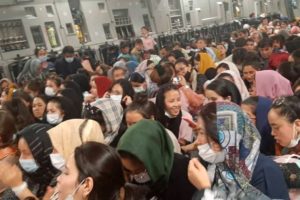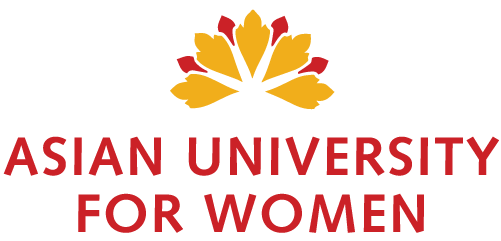SEPTEMBER 2, 2021

Students from the Asian University for Women fly from Kabul to a base in Saudi Arabia aboard a U.S. military plane.
Bullets had pierced one of the buses carrying 148 students and alumnae from the Asian University for Women who were trying to leave Afghanistan.
As they tried to make their way to Kabul’s international airport, desperate families tried to break down the buses’ doors, convinced that on board they would have a better chance of making it through the heavily guarded gates.
And when a suicide bomber detonated his explosives in the crowd on August 26, killing more than 200 people, including 13 members of the U.S. military, as well as many children, the students were close enough to see the flames.
Kamal Ahmad, the university’s founder, had to make a tough decision. After more than 30 hours of trying to get to the airport, the students were exhausted and frightened. “It became too volatile in the middle of the night,” Ahmad said, “too dangerous.”
Coordinating with the students via the social-messaging app WhatsApp from Bangladesh, where the university is located, Ahmad debated: Should he encourage the group to keep trying, no matter how unsafe?
The risk to the students, as young, educated Afghan women, could be much greater, he knew, if they didn’t escape the Taliban.
The Asian University for Women, or AUW, is an unusual institution. It enrolls some 800 women from across Asia, studying a liberal-arts curriculum. Most students are low income, some are refugees. Many come speaking little English, the language of instruction.
But Ahmad, a lawyer born in Bangladesh and educated at Harvard and the University of Michigan, believes that educating women is the key to change — in their lives, for their communities, across Asia. The critical thinking and inquiry at the core of the liberal arts, he once told me, help “women take charge of their lives, with their mind their instrument of power.”
Three years ago, I traveled to Chittagong, Bangladesh, the dusty, vibrant city where AUW is located, to report on this intriguing educational experiment, which enrolled its first students in 2012. Over the last few weeks, I’ve been following Ahmad’s regular email updates as he and his colleagues sought to get the students out of Afghanistan, where they had returned to study remotely because of Covid-19.
By late June, as the Taliban made quick advances across Afghanistan’s provinces ahead of a planned withdrawal of American military forces, Ahmad knew he needed to act. Students from Afghanistan are the second-largest group at AUW, hungry for educational opportunities infrequently available to them at home, even under a more-moderate government. Things would very likely be much worse under the Taliban, which has opposed education, particularly of women and girls, and targeted students and academics in its attacks.
AUW had 160 current and incoming students in Afghanistan. It also had 70 alumnae working in government, education, nonprofits, and journalism, and Ahmad felt a strong responsibility to them as well.
“It was important for us to protect them,” he said. “You cannot exhort young people to show all these traits that you presumably value, and then, when they exercise them and they’re in trouble, you cannot say, ‘but you’ve already graduated, you’re not part of the community anymore.’”
Ahmad planned to bring the students back to the AUW campus, which was empty except for students who are refugees. The Bangladesh government quickly promised to issue student visas.
The situation was trickier for alumnae, since they are no longer students. Ahmad had long wanted to start a graduate school of education to prepare his students to start their own schools, a sort of educational multiplier effect.
You cannot exhort young people to show all these traits that you presumably value, and then, when they exercise them and they’re in trouble, you cannot say, ‘but you’ve already graduated.’
Now, he reached out to colleagues in the United States. One education-school dean agreed to offer one of his school’s courses via remote instruction, the seeds of an AUW graduate program and enough to qualify the alumnae for visas. (The American college has asked not to be identified because it still has people and ties in Afghanistan.)
But Ahmad had to figure out how to get his students out of Afghanistan. As the security situation worsened, commercial airlines stopped all flights to Kabul. So he set about trying to charter a plane.
Profiteers sought to prey on the desperation of people like Ahmad. One company demanded he wire $365,000 to a bank account; at the last moment, he discovered it was a fraud, and there was no plane. As the Taliban moved into Kabul and the Afghan government fell, prices soared. By last week, charter companies were charging $1 million a flight, Ahmad said, far beyond AUW’s budget.
Still, Ahmad began to think that the flight would be the easy part, compared with getting his students to the airport. Its perimeter was besieged by Afghans and foreigners trying to leave. Fears of attacks were high. Although AUW had chartered seven buses, with drivers and unarmed guards, the university had no staff members on the ground. The students would have to travel across Kabul largely on their own.
The students stepped up. Sepehra Azami, a third-year student, became their leader. Growing up in a poor family in rural Afghanistan, Azami had little hope of earning a college degree until she won a scholarship to AUW. There, she studied economics and represents the Afghan students.
When the Taliban took over, the NGO where Azami worked, in addition to her remote studies, burned all its papers and sent employees home. For days, she was afraid to leave the house, asking her younger brother to run errands for her. She knew she needed to leave Afghanistan for her own safety, and she worried that she could make her family vulnerable because of her gender and education.
Azami worked with a team of six other students, one for each of the buses that were to pick up students and alumnae from different parts of the city. The first attempt was on August 24, last Tuesday. But before the buses could even approach the airport, Ahmad got a message from a U.S. military officer, warning the group to turn back because of the danger.
The next day, they set out again. The women wore the burqa, fully veiling themselves so as to not attract attention. On the streets, armed militants patrolled in cars, and shootings broke out. Close to the airport it was chaos, as the clock ran down on the time to get out.
Azami felt anguish. “Afghanistan is my home, and Kabul is my heart,” she said. “It is very difficult to witness Kabul being destroyed before my eyes.”
Ahmad and other university officials connected with the student leaders through WhatsApp and monitored their progress via a tracking app installed on each student’s phone. They watched as the caravan was turned away from one gate then another and another and another. Administrators reached out to contacts from the military, the U.S. State Department, foreign embassies, and international-aid organizations, but to no avail.
On the ground, the situation was deteriorating. The smoke from the suicide blasts was visible. Amid frequent gunfire, one of the buses was shot at. Finally, after many hours, early on Friday morning, the decision was made to return students home.
On Friday afternoon, the entire group met virtually and decided to try again. At times, both buses and individual students were detained, supposedly because of missing or improper paperwork, but eventually everyone made it through both Taliban and U.S. military checkpoints and onto the airport grounds.
When the students boarded a plane for an American military base in Riyadh, Saudi Arabia, on Saturday afternoon, it wasn’t a million-dollar charter but a spartan military transport. The AUW group sat together on the floor at the front of the plane. No one spoke, Azami said.
“We all avoided looking at each other. Everyone is so tired, so sad, so heartbroken,” she said. “We didn’t want anyone to see that we are crying out. We felt that if we looked at each other, we might start crying.”
Despite the lack of comfort, not long after takeoff, everyone fell asleep, worn out by stress. Three students missed the flight. Separated from the group to charge their phones, they, too, fell asleep and woke up to find they had been left behind. They were able to get a later military flight to a base in Doha, Qatar, where they volunteered to work as translators.
When I spoke to Azami on Thursday, she was in Spain, en route not to the AUW campus in Bangladesh but to Dulles International Airport, outside Washington, D.C. Because the students had been airlifted out by the American military, they were being taken to the United States, where they expected to be able to stay, at least temporarily. Ahmad said he is talking with American colleges in hopes that some might admit the AUW students.
Students at the American University of Afghanistan have not been as fortunate. Media reports say the United States has so far failed to get them out of the country.
With his group all safe, Ahmad has a new focus: He plans to admit 200 additional Afghan students and, when the chaos of the American withdrawal has subsided, bring them to AUW.
Azami said she had not yet decided whether she wanted to study in the United States or return to Bangladesh. For days, she has been running on adrenaline, with no time to sleep or cry. “I am hopeful,” she said, “and I am heartbroken.”
